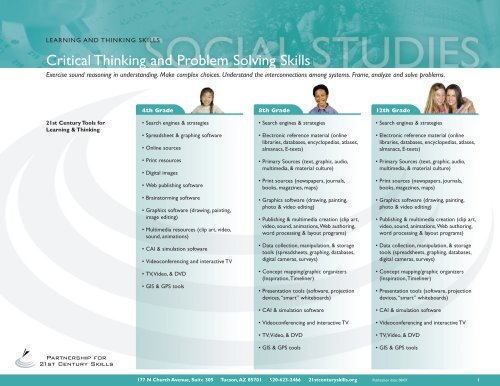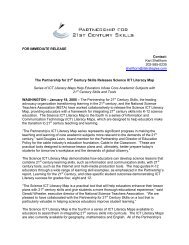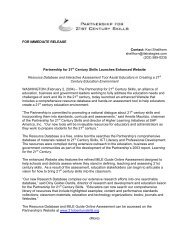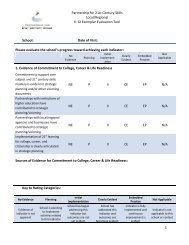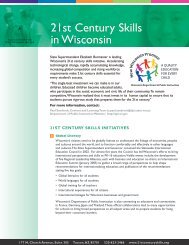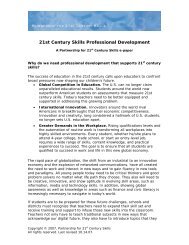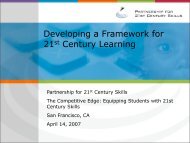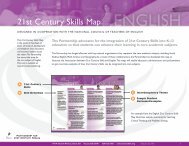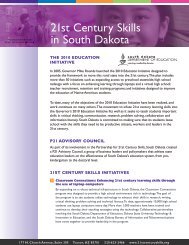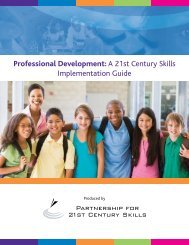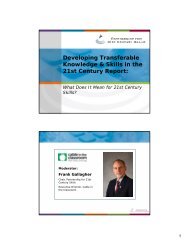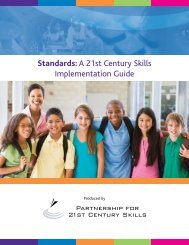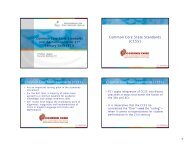Critical Thinking and Problem Solving Skills - The Partnership for ...
Critical Thinking and Problem Solving Skills - The Partnership for ...
Critical Thinking and Problem Solving Skills - The Partnership for ...
You also want an ePaper? Increase the reach of your titles
YUMPU automatically turns print PDFs into web optimized ePapers that Google loves.
Learning <strong>and</strong> thinking <strong>Skills</strong><strong>Critical</strong> <strong>Thinking</strong> <strong>and</strong> <strong>Problem</strong> <strong>Solving</strong> <strong>Skills</strong>Exercise sound reasoning in underst<strong>and</strong>ing. Make complex choices. Underst<strong>and</strong> the interconnections among systems. Frame, analyze <strong>and</strong> solve problems.4th Grade 8th Grade 12th Grade21st Century Tools <strong>for</strong>Learning & <strong>Thinking</strong>• Search engines & strategies• Spreadsheet & graphing software• Online sources• Search engines & strategies• Electronic reference material (onlinelibraries, databases, encyclopedias, atlases,almanacs, E-texts)• Search engines & strategies• Electronic reference material (onlinelibraries, databases, encyclopedias, atlases,almanacs, E-texts)• Print resources• Digital images• Web publishing software• Primary Sources (text, graphic, audio,multimedia, & material culture)• Print sources (newspapers, journals,books, magazines, maps)• Primary Sources (text, graphic, audio,multimedia, & material culture)• Print sources (newspapers, journals,books, magazines, maps)• Brainstorming software• Graphics software (drawing, painting,image editing)• Multimedia resources (clip art, video,sound, animations)• Graphics software (drawing, painting,photo & video editing)• Publishing & multimedia creation (clip art,video, sound, animations, Web authoring,word processing & layout programs)• Graphics software (drawing, painting,photo & video editing)• Publishing & multimedia creation (clip art,video, sound, animations, Web authoring,word processing & layout programs)• CAI & simulation software• Videoconferencing <strong>and</strong> interactive TV• Data collection, manipulation, & storagetools (spreadsheets, graphing, databases,digital cameras, surveys)• Data collection, manipulation, & storagetools (spreadsheets, graphing, databases,digital cameras, surveys)• TV, Video, & DVD• GIS & GPS tools• Concept mapping/graphic organizers(Inspiration, Timeliner)• Presentation tools (software, projectiondevices, “smart” whiteboards)• Concept mapping/graphic organizers(Inspiration, Timeliner)• Presentation tools (software, projectiondevices, “smart” whiteboards)• CAI & simulation software• CAI & simulation software• Videoconferencing <strong>and</strong> interactive TV• Videoconferencing <strong>and</strong> interactive TV• TV, Video, & DVD• TV, Video, & DVD• GIS & GPS tools• GIS & GPS tools177 N Church Avenue, Suite 305 Tucson, AZ 85701 520-623-2466 21stcenturyskills.org Publication date: 08/07
Learning <strong>and</strong> thinking <strong>Skills</strong><strong>Critical</strong> <strong>Thinking</strong> <strong>and</strong> <strong>Problem</strong> <strong>Solving</strong> <strong>Skills</strong> (continued)Exercise sound reasoning in underst<strong>and</strong>ing. Make complex choices. Underst<strong>and</strong> the interconnections among systems. Frame, analyze <strong>and</strong> solve problems.4th Grade 8th Grade 12th GradeSAMPLE Student Outcomes<strong>for</strong> Learning & <strong>Thinking</strong>1. Use digital reference material to identify<strong>and</strong> describe the natural resources,human resources, <strong>and</strong>/or capital goodsneeded <strong>for</strong> proposed economic activity inthe regional community or state.E.G. Students will research onthe Internet the composition ofSouthwestern adobe, in order to dig theappropriate soil to make small adobebricks <strong>for</strong> a model of a 17th centurymission (San Xavier del Bac, MissionSanta Barbara, San Diego de Alcala, etc.).2. Use technology to graphically display dataused to make a complex choice involvinga regional community or state publicissue.1. Analyze problems in the past <strong>and</strong>evaluate the decisions made byindividuals <strong>and</strong> groups involved.E.G. Students use online databases <strong>and</strong>search engines to locate primary sourcematerial from the Civil Rights Movement<strong>and</strong> identify the problems the movementintended to address. Students presentthis in<strong>for</strong>mation in a slide show <strong>and</strong>evaluate the effectiveness of a specificevent, such as the 1965 march on Selma,Alabama, in reaching the movement’sgoals. Students then explore their localcommunity <strong>for</strong> examples of equal rights,whether related to race, age, gender, orculture <strong>and</strong> document these examplesusing digital cameras.1. Analyze contemporary problems <strong>and</strong>evaluate the decisions made by individuals<strong>and</strong> groups involved.E.G. In groups, students use the Internet<strong>and</strong> digital libraries to identify <strong>and</strong>analyze the work being done by variousorganizations to provide alternative,sustainable economic <strong>and</strong> environmentalresponses to significant resourcedepletion in specific regions. Studentgroups create wikis that explain theirperspective on the effectiveness of theorganizations.2. Identify <strong>and</strong> analyze different ways thatelectronic news sources define <strong>and</strong>present a problem.E.G. Students will make a spreadsheetshowing the funding provided by schooldistricts within their state <strong>for</strong> eachpublic school pupil; they will display thein<strong>for</strong>mation alphabetically <strong>and</strong> then bylargest to smallest dollar amount, <strong>and</strong>discuss their observations about this data.Which districts do they think will be themost sought after <strong>and</strong> why? What mightthe differences be in the schools in thelowest funded areas compared with thehighest funded areas?2. Evaluate ethical considerations relatedto an issue or problem <strong>and</strong> determinewhether alternative courses of actionare/were available <strong>and</strong>/or viable given thecircumstances.E.G. Students <strong>and</strong> teacher brainstorma list of problems from the recent past,such as responses to the 9/11 attacks, orhurricanes Katrina, <strong>and</strong> Rita. Cooperativegroups choose a problem, developideas <strong>for</strong> finding materials online thatdetail the issues, <strong>and</strong> provide possiblesolutions, Groups use this in<strong>for</strong>mationto evaluate the steps that were takento deal with the problem they chose toE.G. Students use various online newsmedia sources from different areas inthe Middle East to analyze how eachdescribes the relations between Israel <strong>and</strong>Palestine <strong>and</strong> the reasons <strong>for</strong> the conflictsin that region. <strong>The</strong>y then compare theseportrayals with digitized primary newsreports of the founding of Israel <strong>and</strong>articulate how <strong>and</strong> why the descriptions<strong>and</strong> explanations of the conflict differ.3. Collect <strong>and</strong> analyze in<strong>for</strong>mation about apublic policy issue from diverse electronicnews sources, look <strong>for</strong> bias <strong>and</strong> analyzehow the in<strong>for</strong>mation is interpreteddifferently.177 N Church Avenue, Suite 305 Tucson, AZ 85701 520-623-2466 21stcenturyskills.org Publication date: 08/07
Learning <strong>and</strong> thinking <strong>Skills</strong><strong>Critical</strong> <strong>Thinking</strong> <strong>and</strong> <strong>Problem</strong> <strong>Solving</strong> <strong>Skills</strong> (continued)Exercise sound reasoning in underst<strong>and</strong>ing. Make complex choices. Underst<strong>and</strong> the interconnections among systems. Frame, analyze <strong>and</strong> solve problems.4th Grade 8th Grade 12th GradeSAMPLE Student Outcomes<strong>for</strong> Learning & <strong>Thinking</strong>(continued)3. Access in<strong>for</strong>mation to discover theinterconnections between the role ofgovernment <strong>and</strong> a service it provides tothe public.E.G. All fourth graders in a schoolwill be surveyed <strong>for</strong> sports <strong>and</strong> hobbyinterests, <strong>and</strong> results will be reported ingraphs. Students will use GIS <strong>and</strong> GPSto show the location of areas in whichthese sports can be played throughouttheir community.investigate. Groups then create a multimediapresentation to teach the classtheir findings, or create an online blogin which students suggest <strong>and</strong> debatealternatives that might have been taken.3. Identify <strong>and</strong> analyze different ways thatelectronic news sources define <strong>and</strong>present a problem.E.G. Students conduct an online search<strong>and</strong> compile representative news reportsabout persons of Middle Eastern descentpublished in major online news sourcesaround the country. Working in smallgroups, students review, analyze <strong>and</strong>discuss any apparent biases evident inthe way news agencies report incidentsof ethnic profiling <strong>and</strong>/or cooperationamong various ethnic groups in America.Groups present their findings to theclass in a slide show <strong>for</strong>mat <strong>and</strong>/orpodcast.4. Use electronic charting <strong>and</strong> graphic toolsto graphically display data that can beused to make a complex choice involvinga regional community or state publicissue.E.G. Using electronic referencematerial, students investigate the issuesinvolved (economic feasibility, asbestosremoval), <strong>and</strong> resources that would beneeded to renovate a school built inE.G. Students gather in<strong>for</strong>mation onglobal warming from diverse electronicsources such as the United Nations,scientific associations, <strong>and</strong> non-profitorganizations; research the organizations;<strong>and</strong> analyze how the beliefs <strong>and</strong> natureof the organization might influencethe interpretation of the in<strong>for</strong>mation.Using programs such as Timeliner orGIS, students then illustrate the history<strong>and</strong> impact of global warming on U.S.Territories. Students produce a newsbroadcast explaining the issue of globalwarming from the perspective of aresident of one of these territories.4. Demonstrate an underst<strong>and</strong>ing throughthe use of technology about how therelationship among social, economic <strong>and</strong>governmental systems affects change in acommunity over time.E.G. Working in groups, students followan inquiry approach to analyze <strong>and</strong>present the relationship between changesin population in communities <strong>and</strong> zoningdecisions made by local governments overa 20-year period by using in<strong>for</strong>mationsuch as GIS, census data, digitized zoning<strong>and</strong> population distribution maps, <strong>and</strong>electronic transcripts of local governmentmeetings.5. Use technology to research <strong>and</strong> graphicallydisplay a reasonable prediction about apublic issue.177 N Church Avenue, Suite 305 Tucson, AZ 85701 520-623-2466 21stcenturyskills.org Publication date: 08/07
Learning <strong>and</strong> thinking <strong>Skills</strong>In<strong>for</strong>mation <strong>and</strong> Media LiteracyUnderst<strong>and</strong>, manage <strong>and</strong> create effective oral, written <strong>and</strong>/or multimedia communication in a variety of <strong>for</strong>ms <strong>and</strong> contexts. Analyze, access, manage, integrate,evaluate <strong>and</strong> create in<strong>for</strong>mation in a variety of <strong>for</strong>ms <strong>and</strong> media.4th Grade 8th Grade 12th Grade21st Century Tools <strong>for</strong>Learning & <strong>Thinking</strong>• Search engines & strategies• Spreadsheet & graphing software• Search engines & strategies• Spreadsheet & graphing software• Search engines & strategies• Spreadsheet & graphing software• Online sources• Online sources• Online sources• Print resources• Print resources• Print resources• Digital images• Digital images• Digital images• Web publishing software• Web publishing software• Web publishing software• Brainstorming software• Brainstorming software• Brainstorming software• Graphics software (drawing, painting,image editing)• Graphics software (drawing, painting,image editing)• Graphics software (drawing, painting,image editing)• Multimedia resources (clip art, video,sound, animations)• Multimedia resources (clip art, video,sound, animations)• Multimedia resources (clip art, video,sound, animations)• CAI & simulation software• CAI & simulation software• CAI & simulation software• Videoconferencing <strong>and</strong> interactive TV• Videoconferencing <strong>and</strong> interactive TV• Videoconferencing <strong>and</strong> interactive TV• TV, Video, & DVD• TV, Video, & DVD• TV, Video, & DVD• GIS & GPS tools• GIS & GPS tools• GIS & GPS tools• Collaboration tools (wikis, listservs,email, asynchronous conferencing, Chat)• Collaboration tools (wikis, listservs,email, asynchronous conferencing, Chat)• Collaboration tools (wikis, listservs,email, asynchronous conferencing, Chat)• Blogs (text & video)• Blogs (text & video)• Podcasts• Podcasts177 N Church Avenue, Suite 305 Tucson, AZ 85701 520-623-2466 21stcenturyskills.org Publication date: 08/07 10
Learning <strong>and</strong> thinking <strong>Skills</strong>In<strong>for</strong>mation <strong>and</strong> Media Literacy (continued)Underst<strong>and</strong>, manage <strong>and</strong> create effective oral, written <strong>and</strong>/or multimedia communication in a variety of <strong>for</strong>ms <strong>and</strong> contexts. Analyze, access, manage, integrate,evaluate <strong>and</strong> create in<strong>for</strong>mation in a variety of <strong>for</strong>ms <strong>and</strong> media.4th Grade 8th Grade 12th Grade21st Century Tools <strong>for</strong>Learning & <strong>Thinking</strong>(continued)E.G. Interview a family member aboutthe changes over time in his/hercommunity. Present the main pointsthat result from the interview in a slideshow that integrates video images.4. Describe the roles <strong>and</strong> responsibilitiesof their elected officials.E.G. Students download e-textbiographies of their Governor, Senators,<strong>and</strong>/or Representatives <strong>and</strong> use agraphic organizer tool to display theroles <strong>and</strong> responsibilities of each.E.G. Students analyze sources ofin<strong>for</strong>mation about transportationsystems used over time <strong>and</strong> drawconclusions about how they are relatedto changes in population distribution.4. Locate <strong>and</strong> select sources, representingseveral types of media, which discuss anelected official’s time in office.E.G. Students create a slideshow orwiki comparing <strong>and</strong> contrasting theadministrations of several of the earlyAmerican presidents.4. Locate <strong>and</strong> select sources, representingseveral types of media, which enableone to assess an elected official’seffectiveness while in office.E.G. Students compare <strong>and</strong> contrastthe voting records of different state<strong>and</strong> local officials on issues that impacttheir community, such as education <strong>and</strong>taxes, using digital presentation methods(podcast, slideshow, website or blog).5. Use technology tools to present <strong>and</strong>analyze data in a meaningful way.5. Use drawing or timeline software toolsto create a timeline of events.E.G. Using graphics or presentationsoftware, students create an electronictimeline of events leading up tothe writing of the Declaration ofIndependence.6. Access the expertise of sources outsidetheir own community.5. Use concept mapping software togenerate <strong>and</strong> present characteristics,causes, <strong>and</strong> effects of politicalrevolutions.E.G. Students map the characteristicsof the American Revolution, the FrenchRevolution, the Russian Revolution, <strong>and</strong>a Latin American revolution.E.G. Create a spreadsheet <strong>and</strong> fromit a graph to display comparativeprices over a month of three stocks indifferent sectors (high tech, hospitality,communications, etc.); conduct researchonline to describe possible reasons <strong>for</strong>the fluctuations <strong>and</strong> trends evidenced bythe data.E.G. Students participate in anonline discussion or interactivevideoconference with a museumeducator in order to discuss <strong>and</strong> analyzean artifact found in the student’s localcommunity, drawing conclusions aboutthe item’s purpose <strong>and</strong> probable owner.177 N Church Avenue, Suite 305 Tucson, AZ 85701 520-623-2466 21stcenturyskills.org Publication date: 08/07 12
Learning <strong>and</strong> thinking <strong>Skills</strong>Creativity <strong>and</strong> Innovation <strong>Skills</strong>Demonstrate originality <strong>and</strong> inventiveness in work. Developing, implementing <strong>and</strong> communicating new ideas to others. Being open <strong>and</strong> responsive to new <strong>and</strong>diverse perspectives.4th Grade 8th Grade 12th Grade21st Century Tools <strong>for</strong>Learning & <strong>Thinking</strong>• Graphics software (drawing, painting,image editing)• Graphics software (drawing, painting,image editing)• Graphics software (drawing, painting,image editing)• Web publishing software• Web publishing software• Web publishing software• Desktop publishing software (wordprocessing & layout programs)• Desktop publishing software (wordprocessing & layout programs)• Desktop publishing software (wordprocessing & layout programs)• Spreadsheet & graphing software• Spreadsheet & graphing software• Spreadsheet & graphing software• Database creation software• Database creation software• Database creation software• Concept mapping/graphic organizers(ex. Inspiration, Timeliner)• Concept mapping/graphic organizers (ex.Inspiration, Timeliner)• Concept mapping/graphic organizers (ex.Inspiration, Timeliner)• Collaboration tools (wikis, listservs,email, asynchronous conferencing, Chat)• Presentation tools• GIS & GPS tools• CAI software• Videoconferencing <strong>and</strong> interactivetelevision• Production tools (Digital photography &video)• Blogs• Collaboration tools (wikis, listservs,email, asynchronous conferencing, Chat,MUD, MOO)• Presentation tools• GIS & GPS tools• CAI software• Videoconferencing <strong>and</strong> interactivetelevision• Production tools (Digital photography &video)• Blogs• Collaboration tools (wikis, listservs,email, asynchronous conferencing, Chat)• Presentation tools• GIS & GPS tools• CAI software• Videoconferencing <strong>and</strong> interactivetelevision• Production tools (Digital photography &video)• Blogs177 N Church Avenue, Suite 305 Tucson, AZ 85701 520-623-2466 21stcenturyskills.org Publication date: 08/07 13
Learning <strong>and</strong> thinking <strong>Skills</strong>Creativity <strong>and</strong> Innovation <strong>Skills</strong> (continued)Demonstrate originality <strong>and</strong> inventiveness in work. Developing, implementing <strong>and</strong> communicating new ideas to others. Being open <strong>and</strong> responsive to new <strong>and</strong>diverse perspectives.4th Grade 8th Grade 12th Grade21st Century Tools <strong>for</strong>Learning & <strong>Thinking</strong>Demonstrate creativity <strong>and</strong> share newideas <strong>and</strong> perspectives by incorporatingwork in the social sciences withtechnology, to invent products such asplays, games, dances, puzzles, models,writings, speeches, etc.Demonstrate creativity <strong>and</strong> share newideas <strong>and</strong> perspectives by incorporatingwork in the social sciences withtechnology, to invent products such asplays, games, dances, songs, puzzles, models,writings, speeches, etc.Demonstrate creativity <strong>and</strong> share newideas <strong>and</strong> perspectives by incorporatingwork in the social sciences withtechnology, to invent products such asplays, games, dances, songs, puzzles, models,writings, speeches, etc.E.G.1. Using electronic drawing tools, re-designthe student’s state flag, using in<strong>for</strong>mationfrom the state’s history, geography, arts<strong>and</strong>/or culture.2. Write clues about colonial times into anelectronic crossword puzzle program.3. Take digital photographs of politicalsigns in your neighborhood <strong>and</strong> usea graphics program to create a digitalelection collage.4. Using desktop publishing softwarecreate a newsletter highlighting thismonth’s classroom activities, such asunits studied, field trips, special events,etc.5. Maintain a wiki, <strong>for</strong> youngsters, byyoungsters, <strong>for</strong> sharing opinions aboutglobal problems.6. Participate in asynchronous discussionwith peers in both Israel <strong>and</strong> in Lebanonto better underst<strong>and</strong> issues in that partof the world.7. Create a speech representing one sideof a cultural or religious belief.E.G.1. Invent a Smart Board game modeledon “Chutes <strong>and</strong> Ladders” to illustrateprogress <strong>and</strong> backsliding in the search<strong>for</strong> peace in the Middle East.2. Compose <strong>and</strong> word process inbroadside <strong>for</strong>mat an additional Federalistpaper by “Publius,” using references tothe real Federalist papers.3. Write, enact, <strong>and</strong> film a digitalcommercial <strong>for</strong> either Jefferson orAdams in the election of 1800, asthough there had been television twohundred years ago.4. Compose <strong>and</strong> record an originalCivil War ballad based on the onereproduced online in Harper's Weekly,edition of August 17, 1861. Make therecording available <strong>for</strong> download.E.G.1. Study FDR’s Fireside Chats, <strong>and</strong> thenscript <strong>and</strong> record one of your ownwhich follows the last of the real ones(June 12, 1944, about a war loan drive),<strong>for</strong> any date between June 12th of 1944<strong>and</strong> April 12th, 1945, when Rooseveltdied. Make the recording available <strong>for</strong>download.2. Construct a circle graph depictingwhat a single tax dollar buys. Make itthe centerpiece of a digital poster youcreate <strong>for</strong> this year’s Congressionalelection.3. Create an online poll consisting ofquestions on current issues (the waron terrorism, the invasion of Iraq,immigration, etc.). Solicit 50 classmatesto complete the poll online, thensummarize <strong>and</strong> publish conclusions usingpresentation software.4. With cooperation from your localgovernment or school, organize alistserv that will keep citizens <strong>and</strong>/orstudents abreast of community issues.5. Using GPS <strong>and</strong> GIS, map in yourcommunity hazardous locations of whycertain businesses (day cares, etc) shouldnot be near other locations (traintracks) etc.177 N Church Avenue, Suite 305 Tucson, AZ 85701 520-623-2466 21stcenturyskills.org Publication date: 08/07 14
Learning <strong>and</strong> thinking <strong>Skills</strong>Collaboration <strong>Skills</strong>Demonstrate ability to work effectively with diverse teams. Willing to be helpful <strong>and</strong> make necessary compromises to accomplish a common goal.4th Grade 8th Grade 12th Grade21st Century Tools <strong>for</strong>Learning & <strong>Thinking</strong>• Web publishing software• Brainstorming software• Brainstorming software• Digital networking tools• Brainstorming software• Digital networking tools• Digital networking tools• Authoring software• Authoring software• CAI & simulation software• Email• Email• Videoconferencing <strong>and</strong> interactive TV• Cellular phones• Cellular phones• Authoring software• Blogs• Blogs• Email• Asynchronous discussion boards• Asynchronous discussion boards• Cellular phones• Multimedia production tools• Multimedia production tools• Blogs• Online chat• Online chat• Asynchronous discussion boards• Multimedia production tools• Online chat• Wikis• Listservs• Web publishing <strong>and</strong> desktop publishingsoftware• Wikis• Listservs• Real-time videoconferencing• Web publishing <strong>and</strong> desktop publishingsoftware• Wikis• Listservs• Real-time videoconferencing• Real-time videoconferencing177 N Church Avenue, Suite 305 Tucson, AZ 85701 520-623-2466 21stcenturyskills.org Publication date: 08/07 15
Learning <strong>and</strong> thinking <strong>Skills</strong>Collaboration <strong>Skills</strong> (continued)Demonstrate ability to work effectively with diverse teams. Willing to be helpful <strong>and</strong> make necessary compromises to accomplish a common goal.4th Grade 8th Grade 12th GradeSAMPLE Student Outcomes<strong>for</strong> Learning & <strong>Thinking</strong>1. Work together in pairs <strong>and</strong> small groupsin a specified role to plan, investigate,<strong>and</strong> report the results of their work ona community <strong>and</strong>/or state political orsocial issue.E.G. As news reporters <strong>for</strong> anewspaper/magazine/online journal,students investigate the impact of astate legislative bill m<strong>and</strong>ating the use ofhelmets while riding a bicycle. <strong>The</strong>y thenuse graphics software or other electronicdrawing tools to illustrate the results oftheir study <strong>and</strong> conduct a town meetingwhere their views must be presentedelectronically.2. As a group, work together to reach adecision <strong>and</strong> to explain the reasons <strong>for</strong> it.E.G. Students participate in anasynchronous discussion <strong>for</strong>um abouthow to respond to the state billrequiring bicycle helmets <strong>and</strong> developconsensus about what the team willdo. Using a word processing program,students author a persuasive letter either<strong>for</strong> or against the proposed bill, providingsound reasons to support their position.3. Recognize <strong>and</strong> compare two or moreperspectives on an issue.1. Work together as a group in differentroles to plan, investigate <strong>and</strong> reportthe results of their work on a state ornational political <strong>and</strong>/or social issue.E.G. Students use multiple resources,especially communications technology,to gain perspectives from peers inother locales, <strong>and</strong> to develop a blogthat details the team’s perspective onviolence in schools. Student teams thenprepare an electronic proposal regardingviolence prevention <strong>and</strong> present thisproposal to the school administration.2. Recognize <strong>and</strong> communicate diverseperspectives on an issue <strong>and</strong>demonstrate how diverse perspectivesmight lead to different interpretations ofan issue.E.G. After watching videos of theevents surrounding the desegregationof Little Rock Central High School,students read online first-h<strong>and</strong> accounts,then use online tools to find studentsin other parts of the country withwhom they can discuss <strong>and</strong> compareinterpretations of the events. Studentsthem summarize <strong>and</strong> reflect on theirexperiences in small group discussions.3. Communicate to school or communitymembers about opportunities to assistwith a group project.1. Work in groups, taking various roles toplan, investigate <strong>and</strong> report the results oftheir study on a national or global political<strong>and</strong>/or social issue.E.G. Working in groups, conduct onlineresearch & create a report on HIV/AIDSin the U.S. <strong>and</strong> in Africa, using sites suchas MTV’s Fight <strong>for</strong> Your Rights <strong>and</strong> theUnited Nations’ Cyber Schoolbus, <strong>and</strong>compare the economic, health <strong>and</strong> socialimplications of HIV/AIDS in both settings.2. Reach consensus on a viable action thatcould be taken relative to a political <strong>and</strong>/orsocial issue <strong>and</strong> then act accordingly.E.G. Working in student teams <strong>and</strong> usingonline decision-tree tools, research anissue that is a challenge <strong>for</strong> the localcommunity <strong>and</strong> develop consensus aroundthree specific actions the group will taketo address the issue (e.g., writing lettersto elected representatives, local paper,organizing an email campaign or otheractivity, etc.).Prepare a summary report ofthe group’s decision-making process <strong>and</strong>what action steps were taken.3. Recognize, empathize with, <strong>and</strong>communicate diverse perspectives on anissue <strong>and</strong> realize how one’s perspectiveinfluences one’s interpretation of an issue<strong>and</strong>/or work within a group.177 N Church Avenue, Suite 305 Tucson, AZ 85701 520-623-2466 21stcenturyskills.org Publication date: 08/07 16
Learning <strong>and</strong> thinking <strong>Skills</strong>Collaboration <strong>Skills</strong> (continued)Demonstrate ability to work effectively with diverse teams. Willing to be helpful <strong>and</strong> make necessary compromises to accomplish a common goal.4th Grade 8th Grade 12th GradeSAMPLE Student Outcomes<strong>for</strong> Learning & <strong>Thinking</strong>(continued)E.G. Students select a state, local, orcommunity issue such as recreational useof state property, smoking in restaurants,or skateboarding on sidewalks, <strong>and</strong>demonstrate their underst<strong>and</strong>ing oftwo or more views by using publishingsoftware to develop a Venn diagram thatincludes text <strong>and</strong> images. Conclude bypresenting an argument that endorsesone of the viewpoints.4. Working in small groups, encourage <strong>and</strong>engage other classmates to assist with agroup community service project.E.G. Using digital media, studentsdemonstrate the need of a local foodor animal shelter to raise the awarenessof their classmates on the issue withintheir community. Students then create adigital poster that persuades classmatesto participate in a school fundraisingproject.5. Work as a team to assess individual <strong>and</strong>/or group work.E.G. Working in teams, studentsprepare a digital audio recording, adigital brochure <strong>and</strong> a digital poster <strong>and</strong>distribute these in order to enlist thecommunity’s help with a food drive tobenefit the local food pantry.4. Assess their per<strong>for</strong>mance as a group<strong>and</strong> develop <strong>and</strong> implement a plan towork together more productively.E.G. Students use a wiki orasynchronous discussion board toreflect on a recent group activity,discussing both strengths <strong>and</strong>weaknesses of their team’s interaction<strong>and</strong> productivity.E.G. Conduct an online survey amongcommunity members about the effects ofa recent influx of immigrants <strong>and</strong> compareresponses with digitized accounts fromother communities nationwide. <strong>The</strong>nwork in groups to present two opposingviewpoints on the issue, analyzing themerits of each perspective.4. Engage other students, communitymembers <strong>and</strong>/or other relevant parties toassist with a group ef<strong>for</strong>t.E.G. Host an online chat, present apodcast <strong>and</strong> use a discussion board orlistserv to involve community members inan online debate on global warming.5. Assess their per<strong>for</strong>mance as a group <strong>and</strong>develop <strong>and</strong> implement a plan to worktogether more productively.E.G. Create <strong>and</strong> operate a blog thatdocuments the group’s process, work withthe teacher to review the online account,<strong>and</strong> post a recommended improvementplan <strong>for</strong> the next project.E.G. Using a teacher constructedonline rubric, students work in teams toreview their personal per<strong>for</strong>mance <strong>and</strong>contributions to their team, as well asoverall group per<strong>for</strong>mance.177 N Church Avenue, Suite 305 Tucson, AZ 85701 520-623-2466 21stcenturyskills.org Publication date: 08/07 17


